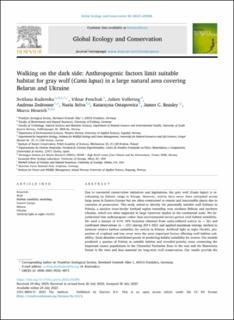| dc.contributor.author | Kudrenko, Svitlana | |
| dc.contributor.author | Fenchuk, Viktar | |
| dc.contributor.author | Vollering, Julien Martin Marie | |
| dc.contributor.author | Zedrosser, Andreas | |
| dc.contributor.author | Selva, Nuria | |
| dc.contributor.author | Ostapowicz, Katarzyna Anna | |
| dc.contributor.author | Beasley, James C. | |
| dc.contributor.author | Heurich, Marco Dietmar | |
| dc.date.accessioned | 2023-08-25T12:16:54Z | |
| dc.date.available | 2023-08-25T12:16:54Z | |
| dc.date.created | 2023-07-29T10:32:19Z | |
| dc.date.issued | 2023 | |
| dc.identifier.citation | Kudrenko, S., Fenchuk, V., Vollering, J., Zedrosser, A., Selva, N., Ostapowicz, K., Beasley, J. C. & Heurich, M. (2023). Walking on the dark side: Anthropogenic factors limit suitable habitat for gray wolf (Canis lupus) in a large natural area covering Belarus and Ukraine. Global Ecology and Conservation, 46, Artikkel e02586. | en_US |
| dc.identifier.issn | 2351-9894 | |
| dc.identifier.uri | https://hdl.handle.net/11250/3085822 | |
| dc.description.abstract | Due to successful conservation initiatives and legislations, the grey wolf (Canis lupus) is re-colonising its historic range in Europe. However, wolves have never been extirpated across large areas in Eastern Europe but are often constrained to remote and inaccessible places due to centuries of persecution. This study aimed to identify the potentially suitable wolf habitats in Polesia, a massive cross-border lowland region extending over southern Belarus and northern Ukraine, which are often neglected in large carnivore studies at the continental scale. We hypothesized that anthropogenic rather than environmental factors govern wolf habitat suitability. We used a dataset of 4191 GPS locations obtained from radio-collared wolves (n = 26) and confirmed observations (n = 231) during 2014–2021 and applied maximum entropy method to estimate relative habitat suitability for wolves in Polesia. Artificial light at night (ALAN), proportion of cropland and tree cover were the most important factors affecting wolf habitat suitability. Road densities contributed poorly to predicting habitat suitability for wolves. Our models predicted a quarter of Polesia as suitable habitat and revealed priority areas connecting the important source populations in the Chornobyl Exclusion Zone in the east and the Białowieża Forest in the west and thus essential for long-term wolf conservation. Our results provide the bases for effective, long-term wolf monitoring and management programs in both Belarus and Ukraine. However, national and transboundary wolf management in Polesia has been extremely challenging since 2022 due to the ongoing war and subsequent habitat degradation in this part of Europe. | en_US |
| dc.language.iso | eng | en_US |
| dc.rights | Navngivelse 4.0 Internasjonal | * |
| dc.rights.uri | http://creativecommons.org/licenses/by/4.0/deed.no | * |
| dc.title | Walking on the Dark Side: Anthropogenic Factors Limit Suitable Habitat for Gray Wolf (Canis lupus) in a Large Natural Area Covering Belarus and Ukraine | en_US |
| dc.type | Peer reviewed | en_US |
| dc.type | Journal article | en_US |
| dc.description.version | publishedVersion | en_US |
| dc.rights.holder | © 2023 The Authors. | en_US |
| dc.source.pagenumber | 12 | en_US |
| dc.source.volume | 46 | en_US |
| dc.source.journal | Global Ecology and Conservation | en_US |
| dc.identifier.doi | https://doi.org/10.1016/j.gecco.2023.e02586 | |
| dc.identifier.cristin | 2163922 | |
| dc.source.articlenumber | e02586 | en_US |
| cristin.ispublished | true | |
| cristin.fulltext | original | |
| cristin.qualitycode | 1 | |

